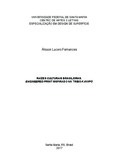| dc.contributor.advisor | Minuzzi, Reinilda de Fátima Berguenmayer | |
| dc.creator | Fernandes, Álisson Lucero | |
| dc.date.accessioned | 2018-06-21T14:45:59Z | |
| dc.date.available | 2018-06-21T14:45:59Z | |
| dc.date.issued | 2017-12-09 | |
| dc.date.submitted | 2017 | |
| dc.identifier.uri | http://repositorio.ufsm.br/handle/1/13494 | |
| dc.description | Monografia (especialização) - Universidade Federal de Santa Maria, Centro de Artes e Letras, Curso de Especialização em Design de Superfície, RS, 2017. | por |
| dc.description.abstract | The main purpose of this study is to develop a collection of men’s fashion, from the creation of the prints, the making of the pilot piece, to the ornaments applied, in which the characteristics of the Brazilian indigenous identity will be explored. For this to be possible, the Engineered Print technique, together with the application of embroidery, was used as the basis for a surface design, giving a three-dimensional and decorative appearance to the fabric. Under a sustainability character, Engineered Print is a technique that encourages the reduction of waste, since the print will be printed in areas located in the molds, applied to shirts made in stamping by sublimation. In this way, the waste is reduced in the unused parts that will be discarded in the cut. As a visual reference, the culture of the Kayapó tribe was used, located between the southern state of Pará and northern Mato Grosso, Brazil, with artistic activities such as body painting and graphics, which were explored in this research. Through support images, it was tried to transpose the values of the culture of the tribe by means of applied prints with the technique of Engineered Print. The present study is based on the methodology of Bernard Löbach (2001), because it is an objective method, which contemplates all aspects for the development of this project. In this way, the proposed collection presents significant aspects and representation of the language, associated to the theme chosen through colors, textures, aesthetics, among others, resulting in six pieces and two lines in the collection. | eng |
| dc.language | por | por |
| dc.publisher | Universidade Federal de Santa Maria | por |
| dc.rights | Acesso Aberto | por |
| dc.rights | Attribution-NonCommercial-NoDerivatives 4.0 International | * |
| dc.rights.uri | http://creativecommons.org/licenses/by-nc-nd/4.0/ | * |
| dc.subject | Design de superfície | por |
| dc.subject | Estamparia têxtil | por |
| dc.subject | Grafismo indígena | por |
| dc.subject | Engineered print | eng |
| dc.subject | Estética | por |
| dc.subject | Corporalidade | por |
| dc.subject | Surface design | eng |
| dc.subject | Textile stamping | eng |
| dc.subject | Indigenous graphics | eng |
| dc.subject | Engineered print | eng |
| dc.subject | Aesthetics | eng |
| dc.subject | Corporality | eng |
| dc.title | Raízes culturais brasileiras: engineered print inspirado na tribo Kayapó | por |
| dc.title.alternative | Brazilian cultural roots: enginnered print inspired by the Kayapó tribe | eng |
| dc.type | Trabalho de Conclusão de Curso de Especialização | por |
| dc.degree.local | Santa Maria, RS, Brasil | por |
| dc.degree.specialization | Design de Superfície | por |
| dc.description.resumo | Este estudo tem como propósito central desenvolver uma coleção de moda masculina, desde a criação das estampas, a confecção da peça piloto, até os ornamentos aplicados, na qual serão exploradas características da identidade indígena brasileira. Para que isso fosse possível utilizou-se a técnica do Engineered Print, juntamente com a aplicação de bordados, como base para o design de superfície, conferindo uma aparência tridimensional e decorativa ao tecido. Sob um caráter de sustentabilidade, o Engineered Print é uma técnica que incentiva a redução de resíduos, já que a estampa será impressa em áreas localizadas nos moldes, aplicada a camisetas feitas em estamparia por sublimação. Dessa forma, diminuem-se os desperdícios nas partes não utilizadas que serão descartadas no corte. Como referência visual foi utilizada a cultura da tribo Kayapó, localizada entre o sul do estado do Pará e norte do Mato Grosso, no Brasil, munida de atividades artísticas, como a pintura corporal e o grafismo, que foram exploradas nesta pesquisa. Através de imagens de apoio, buscou-se transpor os valores da cultura da tribo por meio de estampas aplicadas com a técnica do Engineered Print. O presente estudo tem base na metodologia de Bernard Löbach (2001), por se tratar de um método objetivo, que contempla todos os aspectos para o desenvolvimento deste projeto. Deste modo, a coleção proposta apresenta aspectos significativos e de representação da linguagem, associadas ao tema escolhido através das cores, texturas, estética, entre outros, resultando em seis peças e duas linhas na coleção. | por |
| dc.publisher.country | Brasil | por |
| dc.publisher.initials | UFSM | por |
| dc.subject.cnpq | CNPQ::LINGUISTICA, LETRAS E ARTES | por |
| dc.publisher.unidade | Centro de Artes e Letras | por |



